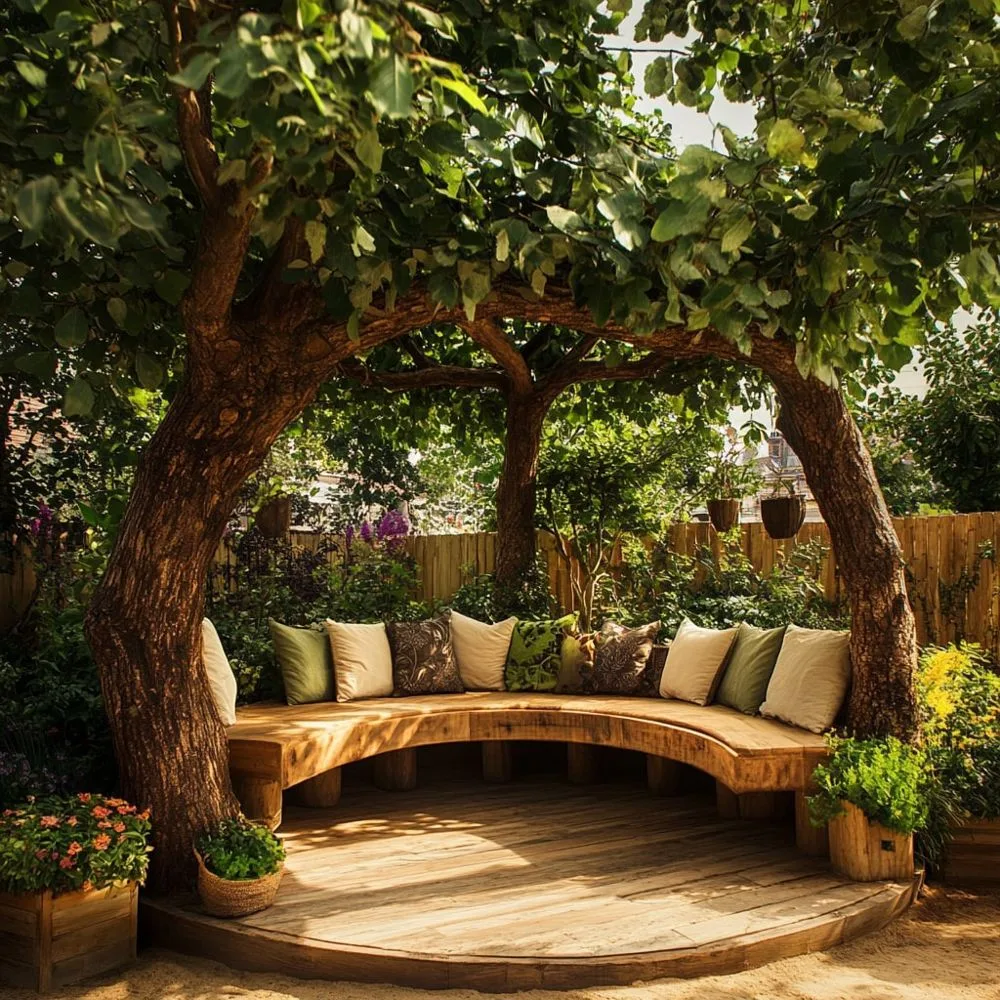Tree gazebos are transforming backyards into serene, nature-integrated retreats. These unique structures combine the elegance of traditional gazebos with the organic beauty of trees, creating a harmonious blend of architecture and nature. Whether you’re looking to enhance your garden, create a cozy outdoor living space, or add value to your property, tree gazebos are an excellent choice. In this comprehensive guide, we’ll explore what makes tree gazebos special, their benefits, design options, installation tips, and more.
What Are Tree Gazebos?

Tree gazebos are outdoor structures designed to incorporate one or more trees into their framework. Unlike standard gazebos, which are freestanding, tree gazebos use trees as natural pillars or central features, blending seamlessly with the environment. These structures can be customized to fit around existing trees, providing shade, shelter, and a unique aesthetic appeal.
Why Choose a Tree Gazebo?
Tree gazebos offer a range of benefits that make them a popular choice for homeowners. They provide a natural, eco-friendly way to enhance your outdoor space while preserving the beauty of your trees. Here are some key reasons to consider a tree gazebo:
- Environmental Integration: Tree gazebos work with nature, not against it, preserving trees and promoting sustainability.
- Aesthetic Appeal: The combination of wood, metal, or vinyl with living trees creates a stunning visual effect.
- Versatility: They can be used for relaxation, entertaining, or as a focal point in your garden.
- Property Value: Unique outdoor features like tree gazebos can increase your home’s market value.
Types of Tree Gazebos
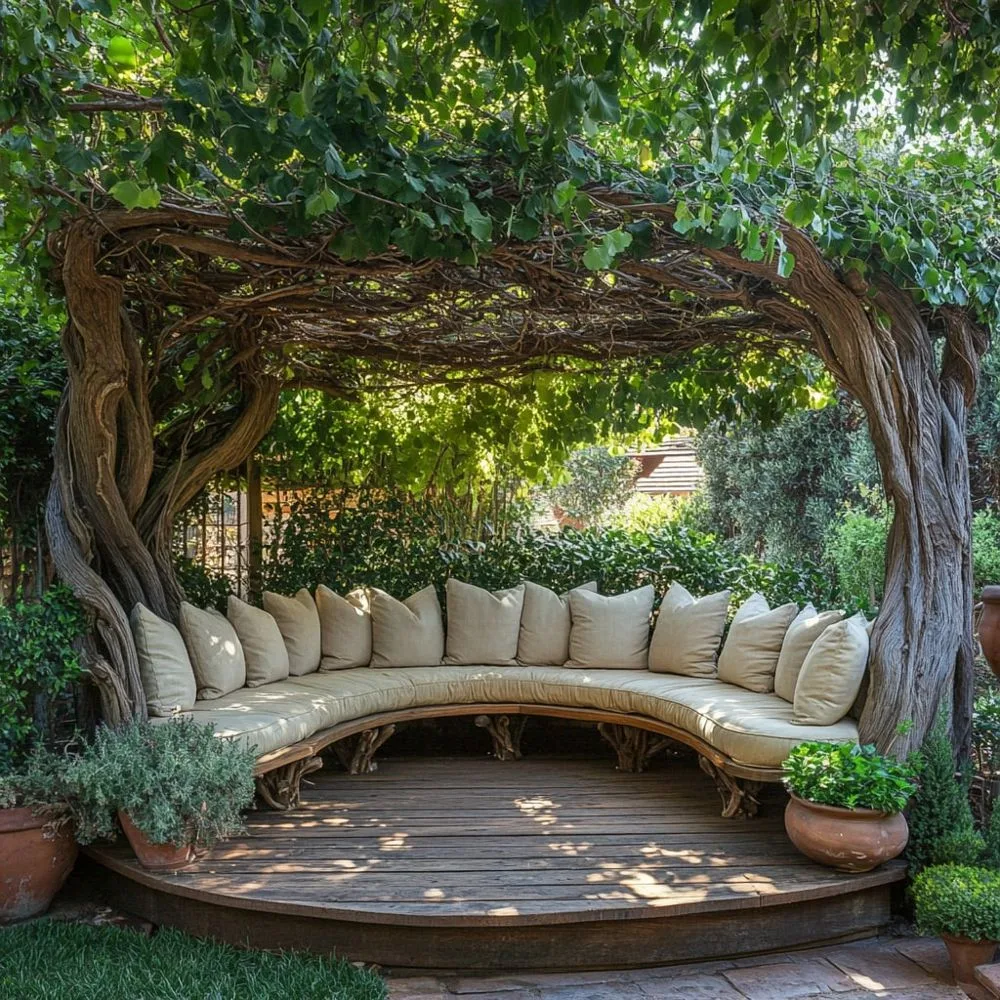
Tree gazebos come in various styles and materials, allowing you to choose one that suits your taste and budget. Below are some popular types of tree gazebos to consider.
Wooden Tree Gazebos
Wooden tree gazebos are a classic choice, offering a rustic and timeless look. Cedar, redwood, and pressure-treated pine are popular wood options due to their durability and resistance to weather conditions. These gazebos can be stained or painted to match your outdoor decor, making them highly customizable.
Metal Tree Gazebos
For a modern and sleek appearance, metal tree gazebos are an excellent option. Aluminum and steel are commonly used, as they are lightweight, durable, and resistant to rust. Metal tree gazebos often feature intricate designs and can be powder-coated in various colors to complement your backyard aesthetic.
Vinyl Tree Gazebos
Vinyl tree gazebos are low-maintenance and long-lasting, making them ideal for homeowners who want a hassle-free option. They resist fading, cracking, and insect damage, and they require minimal upkeep compared to wood or metal. Vinyl gazebos are available in a variety of styles, from traditional to contemporary.
Designing Your Tree Gazebo
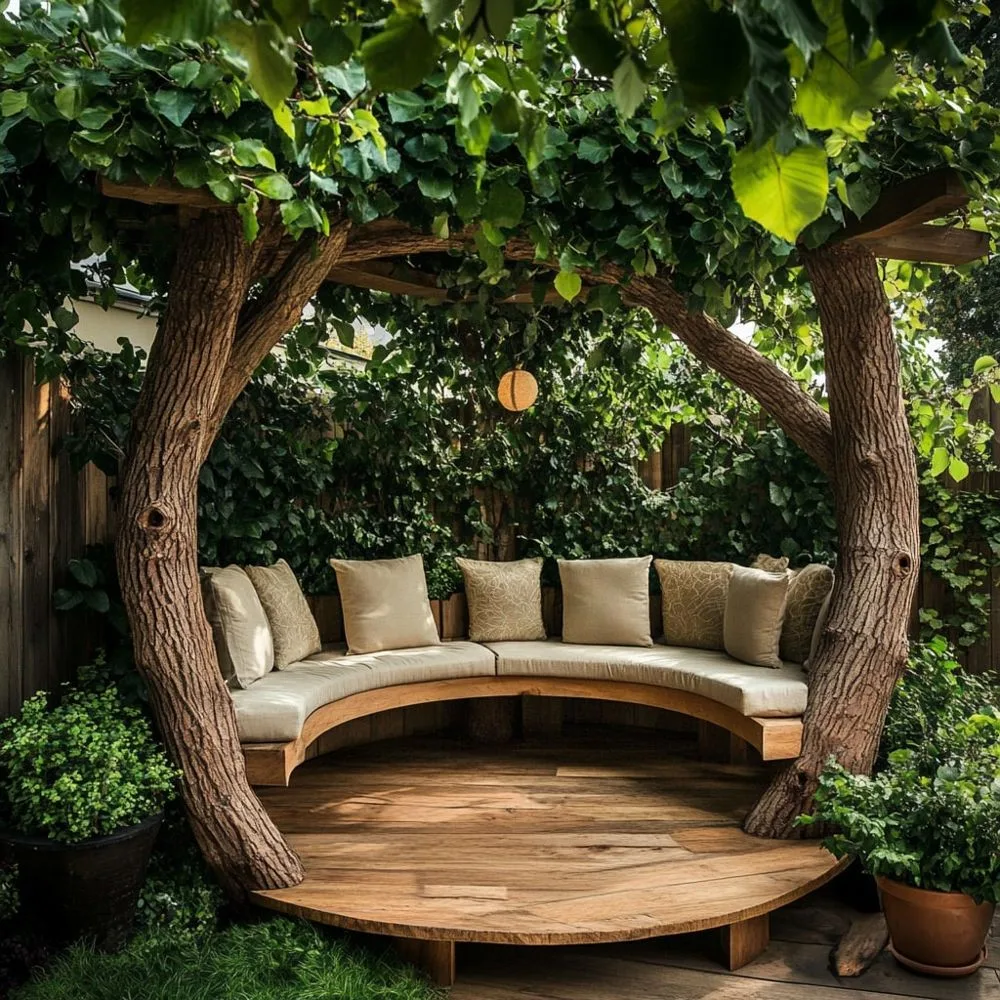
Designing a tree gazebo requires careful planning to ensure it complements both your trees and your outdoor space. Here are some key factors to consider when designing your tree gazebo.
Tree Selection and Placement
Choosing the right tree is crucial for a successful tree gazebo. Opt for sturdy, mature trees with strong trunks and healthy root systems. Common choices include oak, maple, or pine, as they provide ample support and shade. Ensure the tree’s canopy aligns with the gazebo’s roof design to create a cohesive look.
Customizing Around the Tree
Tree gazebos are typically built with cutouts in the roof or floor to accommodate the tree trunk. These cutouts should allow enough space for the tree to grow without damaging the structure. Work with a professional designer to ensure the gazebo is tailored to the tree’s size and growth patterns.
Roof Styles
The roof of a tree gazebo can significantly impact its appearance and functionality. Popular roof styles include:
- Pagoda-Style Roofs: These add an elegant, Asian-inspired touch.
- Gabled Roofs: These offer a traditional, sloped design for better water runoff.
- Open Lattice Roofs: These allow sunlight to filter through, creating a light and airy feel.
Additional Features
To enhance your tree gazebo, consider adding features like built-in seating, lighting, or curtains. Solar-powered lights can create a cozy ambiance for evening gatherings, while weather-resistant curtains provide privacy and shade. You can also incorporate planters or trellises to further integrate the gazebo with your garden.
Benefits of Tree Gazebos
Tree gazebos offer numerous advantages that make them a worthwhile investment for any homeowner. Here’s a closer look at why they’re so appealing.
Enhanced Outdoor Living
A tree gazebo creates a dedicated space for relaxation and entertainment. Whether you’re hosting a barbecue, reading a book, or enjoying a quiet morning coffee, a tree gazebo provides a comfortable and inviting environment.
Eco-Friendly Design
By incorporating existing trees, tree gazebos promote environmental sustainability. They reduce the need for additional construction materials and help maintain the natural ecosystem in your backyard.
Increased Property Value
Unique and well-designed outdoor structures like tree gazebos can boost your home’s curb appeal and market value. Potential buyers are often drawn to properties with thoughtfully designed outdoor spaces.
Installing a Tree Gazebo

Installing a tree gazebo requires careful planning and expertise to ensure safety and longevity. Here’s a step-by-step guide to the installation process.
Step 1: Site Assessment
Begin by assessing your backyard to determine the best location for your tree gazebo. Consider factors like tree health, soil conditions, and accessibility. A professional arborist can evaluate the tree’s stability and recommend any necessary pruning or maintenance.
Step 2: Design and Permits
Work with a designer or contractor to create a custom plan for your tree gazebo. Check local building codes and obtain any necessary permits, as some areas have regulations for outdoor structures.
Step 3: Foundation and Construction
The foundation of a tree gazebo is critical for stability. Depending on the design, you may need a concrete base, gravel, or decking. During construction, ensure the tree is not damaged, and leave enough space around the trunk for growth.
Step 4: Finishing Touches
Once the structure is complete, add finishing touches like paint, stain, or accessories. Test any lighting or electrical components to ensure they’re functioning properly.
Tips for Successful Installation
- Hire experienced professionals to avoid damaging the tree or compromising the structure.
- Use high-quality, weather-resistant materials to ensure durability.
- Schedule regular maintenance to keep the gazebo and tree in top condition.
Maintaining Your Tree Gazebo
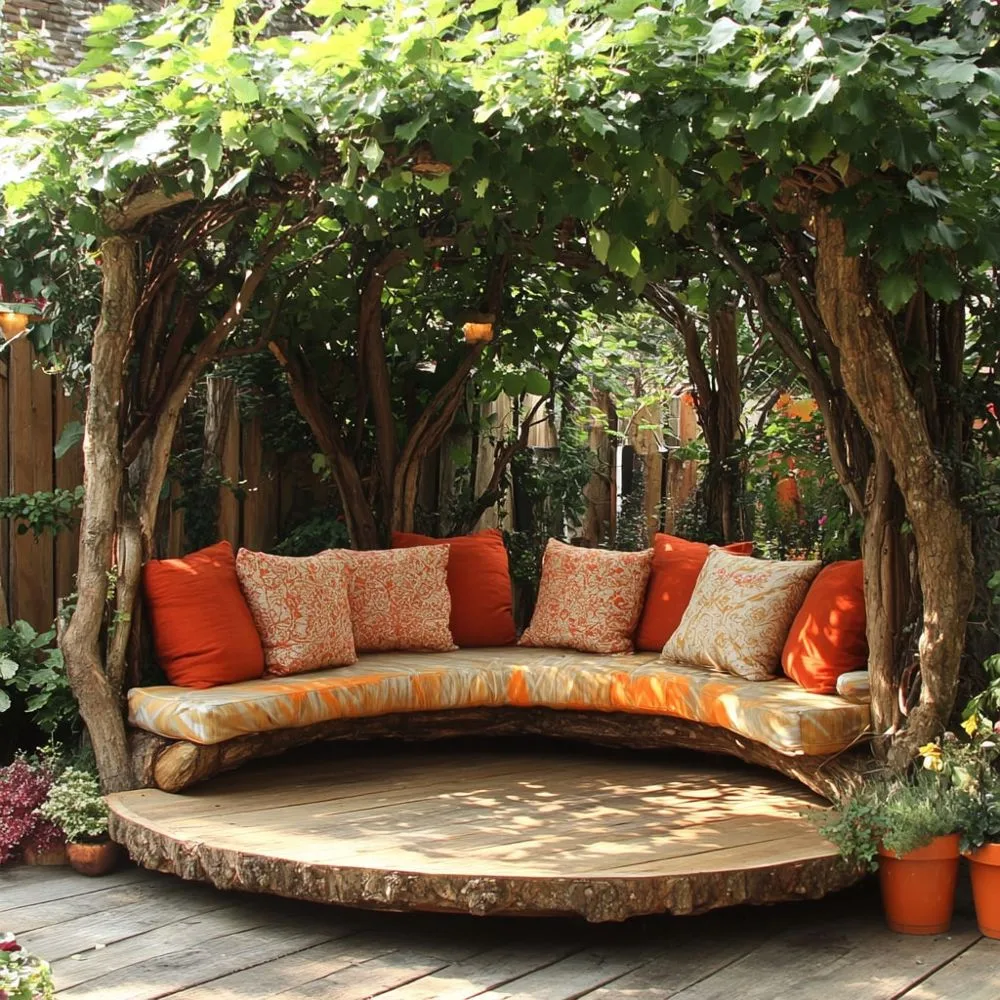
Proper maintenance is essential to keep your tree gazebo looking and functioning its best. Regular upkeep will extend its lifespan and ensure the safety of the tree and structure.
Tree Care
Monitor the tree’s health and growth to prevent it from outgrowing the gazebo. Prune branches as needed and consult an arborist if you notice signs of disease or damage.
Structural Maintenance
Inspect the gazebo annually for signs of wear, such as loose bolts, cracked wood, or rust. Clean the structure regularly to remove dirt, debris, and mildew. For wooden gazebos, apply a sealant every few years to protect against moisture.
Cost of Tree Gazebos
The cost of a tree gazebo varies depending on factors like size, materials, and customization. On average, you can expect to spend between $3,000 and $15,000 for a professionally installed tree gazebo. DIY kits are available for as low as $1,000, but they require significant time and skill to assemble.
Factors Affecting Cost
- Materials: Wood and vinyl are generally more affordable than high-end metals.
- Size: Larger gazebos require more materials and labor.
- Customization: Unique designs or additional features like lighting increase costs.
- Installation: Professional installation is pricier but ensures quality and safety.
Creative Uses for Tree Gazebos

Tree gazebos are incredibly versatile, offering endless possibilities for how you can use them. Here are some creative ideas to make the most of your tree gazebo.
Outdoor Dining Area
Transform your tree gazebo into a charming outdoor dining space. Add a sturdy table, comfortable chairs, and string lights to create an inviting atmosphere for family dinners or dinner parties with friends. The natural shade from the tree will keep your guests cool and comfortable.
Meditation and Yoga Retreat
Create a peaceful oasis for meditation or yoga by furnishing your tree gazebo with cushions, mats, and calming decor. The connection to nature makes it an ideal spot for mindfulness practices, helping you relax and recharge.
Adding Ambiance
Incorporate elements like wind chimes, lanterns, or a small water feature to enhance the tranquil vibe. Soft, neutral-colored curtains can add privacy and a touch of elegance to your retreat.
Children’s Play Area
Turn your tree gazebo into a magical play space for kids. Add a small slide, swings, or a climbing rope for endless fun. The tree’s presence adds a whimsical, treehouse-like feel that children will love.
Home Office or Creative Studio
For those who work from home or enjoy creative pursuits, a tree gazebo can serve as a quiet, inspiring workspace. Equip it with a desk, chair, and storage for supplies. The natural surroundings can boost creativity and productivity.
Seasonal Decorating Ideas for Tree Gazebos
A tree gazebo can be a year-round feature with the right seasonal decorations. Here are some ideas to keep your gazebo looking festive and inviting throughout the year.
Spring
In spring, embrace the season’s renewal by decorating with pastel-colored cushions, floral wreaths, and potted plants. Hang a birdhouse or feeder to attract wildlife and enhance the natural ambiance.
Summer
For summer, add vibrant colors with throw pillows, outdoor rugs, and tropical-themed decor. Install a ceiling fan or misting system to keep the space cool during hot days.
Fall
Celebrate fall with warm tones like orange, red, and brown. Add pumpkins, hay bales, and cozy blankets to create a snug, autumnal vibe. A fire pit nearby can extend the usability of your gazebo into cooler evenings.
Winter
In winter, make your tree gazebo a cozy retreat with string lights, heated blankets, and a portable heater. Decorate with evergreen wreaths and faux snow for a festive, winter wonderland feel.
Troubleshooting Common Tree Gazebo Issues
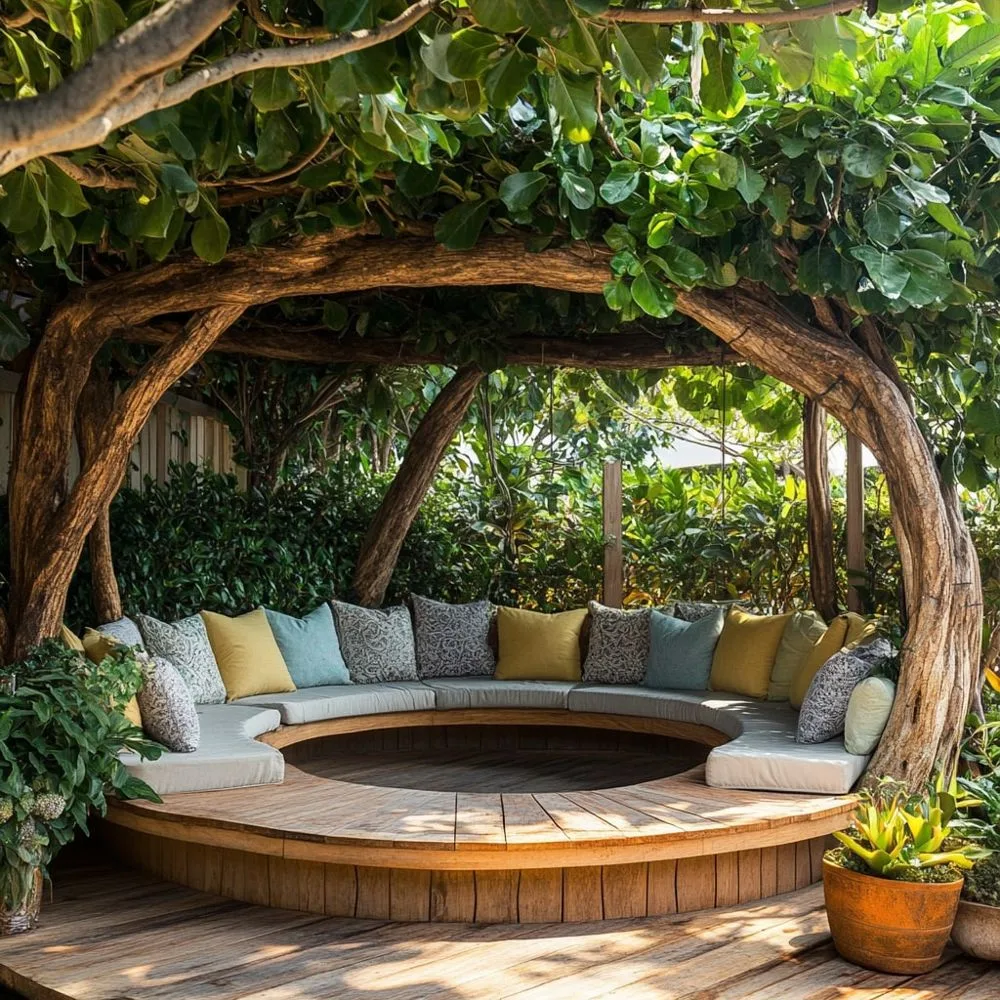
While tree gazebos are generally low-maintenance, you may encounter some challenges. Here’s how to address common issues.
Tree Growth
As the tree grows, it may put pressure on the gazebo structure. Regularly check the cutouts around the trunk and roof to ensure there’s enough space. If necessary, consult a contractor to adjust the structure.
Weather Damage
Harsh weather, such as heavy rain or strong winds, can damage your gazebo. Reinforce the structure with weather-resistant materials and secure loose components before storms. After extreme weather, inspect for damage and make repairs promptly.
Pest Control
Wooden tree gazebos may attract pests like termites. Use treated wood during construction and apply pest-repellent coatings as needed. Regularly inspect for signs of infestation and address issues early.
Choosing a Professional for Your Tree Gazebo
If you’re not opting for a DIY approach, hiring a professional is key to ensuring your tree gazebo is safe and well-constructed. Here’s how to choose the right contractor.
Research and Reviews
Look for contractors with experience in building tree gazebos. Check online reviews and ask for references to gauge their reliability and quality of work.
Portfolio and Expertise
Review the contractor’s portfolio to see examples of their previous tree gazebo projects. Ensure they have expertise in working with trees and understand how to protect them during construction.
Quotes and Contracts
Obtain quotes from multiple contractors to compare pricing and services. Once you’ve chosen a contractor, ensure all details, including costs, timeline, and materials, are outlined in a written contract.
Conclusion
Tree gazebos are a beautiful and functional addition to any backyard, offering a perfect blend of nature and architecture. With their eco-friendly design, aesthetic appeal, and versatility, they create a unique outdoor living space that enhances your home’s value and enjoyment. From choosing the right tree and materials to designing a custom structure and maintaining it over time, every step in the process contributes to creating a stunning and sustainable feature. Whether you envision a cozy retreat, a vibrant entertaining space, or a creative studio, a tree gazebo can bring your outdoor dreams to life. Start planning your tree gazebo today and transform your backyard into a nature-inspired oasis that you’ll cherish for years to come!

